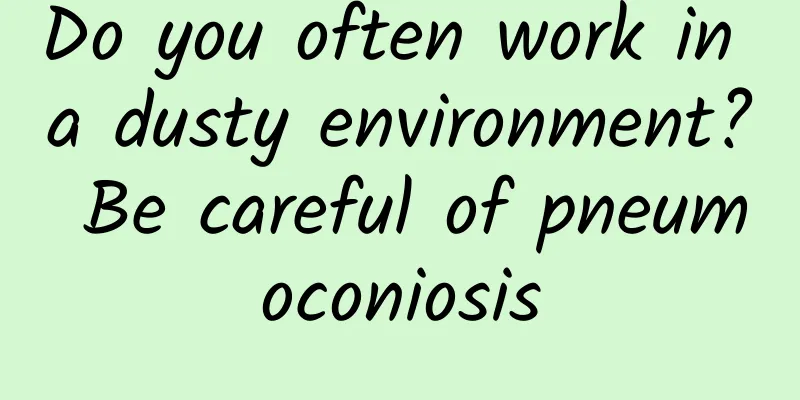Do you often work in a dusty environment? Be careful of pneumoconiosis

|
Pneumoconiosis is one of the statutory occupational diseases. According to the Procuratorate Daily, people suffering from pneumoconiosis account for about 90% of the total number of people suffering from occupational diseases in my country. Therefore, people who often work in dusty environments must be vigilant, take preventive measures, and be careful of pneumoconiosis. Smoke and dust rose as the gravel factory dumped waste stone powder. (Ai Guangde/China News Service) People in which occupations are more likely to suffer from pneumoconiosis? The reason why the number of people suffering from pneumoconiosis is so large is that the occupations that can cause pneumoconiosis are quite wide. According to the Hefei Evening News, rock drillers and rock loaders in the mining industry; Workers who cut and polish stones in the stone processing industry; workers who dry, press, and crush raw materials in the ceramic industry; and workers who saw, plan, and mill in the furniture manufacturing industry are all likely to suffer from pneumoconiosis. Even in industries such as shoemaking, leather processing, and luggage processing, if dust removal, ventilation, and detoxification protection facilities are not properly installed and used in the working environment, pneumoconiosis may also occur. What are the symptoms of pneumoconiosis? According to the Southern Daily, pneumoconiosis refers to a systemic disease characterized by diffuse fibrosis of lung tissue caused by inhalation of industrial dust during occupational activities. Guo Zhiping, director of the Zhongshan Occupational Disease Prevention and Control Institute, said that pneumoconiosis patients often experience respiratory symptoms such as coughing, sputum, chest pain, and difficulty breathing. Severe cases may also experience wheezing, hemoptysis, and certain systemic symptoms. Pneumoconiosis develops slowly, with no obvious symptoms in the early stages, and may not develop until a year or many years later, so it is easy for patients to neglect prevention or miss the best time for treatment. How to prevent pneumoconiosis? Preventing pneumoconiosis requires joint efforts from society, enterprises and individuals. As for individuals, it is necessary to raise awareness of protection and take Protective measures. For example, people who often work in dusty environments should wear designated work clothes, work hats, etc., and try to "hide" themselves. It should be noted that the mouth and nose are The mouth and nose are the key channels for dust to enter the human body, so it is important to protect the mouth and nose. According to Guiyang Daily, ordinary cotton masks can only isolate large dust particles, but are powerless against fine dust. Therefore, according to the nature of the dust, we should choose professional dust masks to build a "firewall" for the human respiratory tract. (Gu Lingyu) This article was scientifically reviewed by Shan Shuxiang, deputy chief physician of the Respiratory Department of Baodi District People's Hospital, Tianjin. |
<<: What are the nutritional values of seaweed? How much seaweed should be eaten at one time?
>>: What is seaweed? What are the functions of seaweed?
Recommend
What are the special items in Tibet? Where is the Yachen Monastery in Tibet?
Tibet has a complex and diverse terrain with nume...
What kind of diet should I pay attention to if I have breast hyperplasia? It's best not to touch these foods
Dear female friends, if you have breast hyperplas...
The safe period is usually a few days after menstruation
Every woman has to bear the responsibility of hav...
What to do if you have a sore throat during early pregnancy
Many expectant mothers have experienced sore thro...
What are the symptoms of zinc deficiency in women?
If the diet is not properly balanced, it is easy ...
Premature ejaculation - surrender at the first sign of failure
Patient A: Doctor, I just got married, and every ...
Bilateral ovarian polycystic changes are so scary
Bilateral polycystic ovary is a perennial gynecol...
How to maintain the uterus after miscarriage?
Accidents are inevitable in life, and unexpected ...
How to treat sagging breasts?
Every woman is always pursuing beauty in life and...
Picture of pimple on female urethra
The pimples on the urethral opening of women may ...
Lychee disease really exists, and the consequences are serious! These 4 types of people should not eat lychees
Lychee, as a treasure among summer fruits, is ric...
Gynecological white blood cell plus sign
If a woman's leucorrhea is checked routinely ...
Can drinking beer help stop breastfeeding?
It is best not to drink alcohol during the weanin...
Can strenuous exercise cause early menstruation?
Menstruation can effectively reflect the physical...
Popular Science丨Adding beauty to the neck and supporting health
The cervical spine is an important anatomical str...









